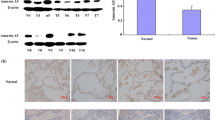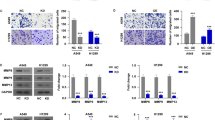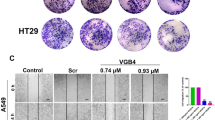Abstract
Low molecular weight heparin (LMWH) improving the cancer survival has been attracting attention for many years. Our previous study found that LMWH (Fraxiparine) strongly downregulated the invasive, migratory, and adhesive ability of human lung adenocarcinoma A549 cells. Here, we aimed to further identify the antitumor effects and possible mechanisms of Fraxiparine on A549 cells and human highly metastatic lung cancer 95D cells. The ability of cell invasion, migration, and adhesion were measured by Transwell, Millicell, and MTT assays. FITC-labeled phalloidin was used to detect F-actin bundles in cells. Chemotactic migration was analyzed in a modified Transwell assay. Measurement of protein expression and phosphorylation activity of PI3K, Akt, and mTOR was performed with Western blot. Our studies found that Fraxiparine significantly inhibited the invasive, migratory, and adhesive characteristics of A549 and 95D cells after 24 h incubation and showed a dose-dependent manner. Fraxiparine influenced the actin cytoskeleton rearrangement of A549 and 95D cells by preventing F-actin polymerization. Moreover, Fraxiparine could significantly inhibit CXCL12-mediated chemotactic migration of A549 and 95D cells in a concentration-dependent manner. Furthermore, Fraxiparine might destroy the interaction between CXCL12-CXCR4 axis, then suppress the PI3K-Akt-mTOR signaling pathway in lung cancer cells. For the first time, our data indicated that Fraxiparine could significantly inhibit the motility of lung cancer cells by restraining the actin cytoskeleton reorganization, and its related mechanism might be through inhibiting PI3K-Akt-mTOR signaling pathway mediated by CXCL12-CXCR4 axis. Therefore, Fraxiparine would be a potential drug for lung cancer metastasis therapy.






Similar content being viewed by others
References
Siegel R, Naishadham D, Jemal A. Cancer statistics, 2012. CA: Cancer J Clin. 2012;62(1):10–29.
Mehlen P, Puisieux A. Metastasis: a question of life or death. Nat Rev Cancer. 2006;6(6):449–58.
Horlocker TT, Heit JA. Low molecular weight heparin: biochemistry, pharmacology, perioperative prophylaxis regimens, and guidelines for regional anesthetic management. Anesth Analg. 1997;85(4):874–85.
Lyman GH, Khorana AA, Falanga A, Clarke-Pearson D, Flowers C, Jahanzeb M, et al. American Society of Clinical Oncology guideline: recommendations for venous thromboembolism prophylaxis and treatment in patients with cancer. J Clin Oncol Off J Am Soc Clin Oncol. 2007;25(34):5490–505.
Altinbas M, Coskun HS, Er O, Ozkan M, Eser B, Unal A, et al. A randomized clinical trial of combination chemotherapy with and without low-molecular-weight heparin in small cell lung cancer. J Thromb Haemost: JTH. 2004;2(8):1266–71.
Lee AY, Rickles FR, Julian JA, Gent M, Baker RI, Bowden C, et al. Randomized comparison of low molecular weight heparin and coumarin derivatives on the survival of patients with cancer and venous thromboembolism. J Clin Oncol Off J Am Soc Clin Oncol. 2005;23(10):2123–9.
Lazo-Langner A, Goss GD, Spaans JN, Rodger MA. The effect of low-molecular-weight heparin on cancer survival. A systematic review and meta-analysis of randomized trials. J Thromb Haemost: JTH. 2007;5(4):729–37.
von Delius S, Ayvaz M, Wagenpfeil S, Eckel F, Schmid RM, Lersch C. Effect of low-molecular-weight heparin on survival in patients with advanced pancreatic adenocarcinoma. Thromb Haemost. 2007;98(2):434–9.
Yilmaz M, Christofori G. EMT, the cytoskeleton, and cancer cell invasion. Cancer Metastasis Rev. 2009;28(1–2):15–33.
Chalkiadaki G, Nikitovic D, Katonis P, Berdiaki A, Tsatsakis A, Kotsikogianni I, et al. Low molecular weight heparin inhibits melanoma cell adhesion and migration through a PKCa/JNK signaling pathway inducing actin cytoskeleton changes. Cancer Lett. 2011;312(2):235–44.
Mellor P, Harvey JR, Murphy KJ, Pye D, O'Boyle G, Lennard TW, et al. Modulatory effects of heparin and short-length oligosaccharides of heparin on the metastasis and growth of LMD MDA-MB 231 breast cancer cells in vivo. Br J Cancer. 2007;97(6):761–8.
Harvey JR, Mellor P, Eldaly H, Lennard TW, Kirby JA, Ali S. Inhibition of CXCR4-mediated breast cancer metastasis: a potential role for heparinoids? Clin Cancer Res: Off J Am Assoc Cancer Res. 2007;13(5):1562–70.
Alsayed Y, Ngo H, Runnels J, Leleu X, Singha UK, Pitsillides CM, et al. Mechanisms of regulation of CXCR4/SDF-1 (CXCL12)-dependent migration and homing in multiple myeloma. Blood. 2007;109(7):2708–17.
Niedermeier M, Hennessy BT, Knight ZA, Henneberg M, Hu J, Kurtova AV, et al. Isoform-selective phosphoinositide 3′-kinase inhibitors inhibit CXCR4 signaling and overcome stromal cell-mediated drug resistance in chronic lymphocytic leukemia: a novel therapeutic approach. Blood. 2009;113(22):5549–57.
Lee YC, Lin HH, Hsu CH, Wang CJ, Chiang TA, Chen JH. Inhibitory effects of andrographolide on migration and invasion in human non-small cell lung cancer A549 cells via down-regulation of PI3K/Akt signaling pathway. Eur J Pharmacol. 2010;632(1–3):23–32.
Yu CJ, Ye SJ, Feng ZH, Ou WJ, Zhou XK, Li LD, et al. Effect of Fraxiparine, a type of low molecular weight heparin, on the invasion and metastasis of lung adenocarcinoma A549 cells. Oncol Lett. 2010;1(4):755–60.
Burger JA, Burger M, Kipps TJ. Chronic lymphocytic leukemia B cells express functional CXCR4 chemokine receptors that mediate spontaneous migration beneath bone marrow stromal cells. Blood. 1999;94(11):3658–67.
Kwiatkowska A, Kijewska M, Lipko M, Hibner U, Kaminska B. Downregulation of Akt and FAK phosphorylation reduces invasion of glioblastoma cells by impairment of MT1-MMP shuttling to lamellipodia and downregulates MMPs expression. Biochim Biophys Acta. 2011;1813(5):655–67.
Lee H, Kim JS, Kim E. Fucoidan from seaweed Fucus vesiculosus inhibits migration and invasion of human lung cancer cell via PI3K-Akt-mTOR pathways. PLoS One. 2012;7(11):e50624.
Li H, Zhang B, Liu Y, Yin C. EBP50 inhibits the migration and invasion of human breast cancer cells via LIMK/cofilin and the PI3K/Akt/mTOR/MMP signaling pathway. Med Oncol. 2014;31(9):162.
Zhang L, Wang H, Zhu J, Ding K, Xu J. FTY720 reduces migration and invasion of human glioblastoma cell lines via inhibiting the PI3K/AKT/mTOR/p70S6K signaling pathway. Tumour Biol: J Int Soc Oncodevelopmental Biol Med. 2014;35(11):10707–14.
Xing X, Zhang L, Wen X, Wang X, Cheng X, Du H, et al. PP242 suppresses cell proliferation, metastasis, and angiogenesis of gastric cancer through inhibition of the PI3K/AKT/mTOR pathway. Anti-Cancer Drugs. 2014;25(10):1129–40.
Tang CH, Tan TW, Fu WM, Yang RS. Involvement of matrix metalloproteinase-9 in stromal cell-derived factor-1/CXCR4 pathway of lung cancer metastasis. Carcinogenesis. 2008;29(1):35–43. doi:10.1093/carcin/bgm220.
Su L, Zhang J, Xu H, Wang Y, Chu Y, Liu R, et al. Differential expression of CXCR4 is associated with the metastatic potential of human non-small cell lung cancer cells. Clin Cancer Res: Off J Am Assoc Cancer Res. 2005;11(23):8273–80.
Jemal A, Siegel R, Ward E, Hao Y, Xu J, Thun MJ. Cancer statistics, 2009. CA: Cancer J Clin. 2009;59(4):225–49.
Temel JS, Greer JA, Muzikansky A, Gallagher ER, Admane S, Jackson VA, et al. Early palliative care for patients with metastatic non-small-cell lung cancer. N Engl J Med. 2010;363(8):733–42.
Vicent S, Luis-Ravelo D, Anton I, Garcia-Tunon I, Borras-Cuesta F, Dotor J, et al. A novel lung cancer signature mediates metastatic bone colonization by a dual mechanism. Cancer Res. 2008;68(7):2275–85.
Icli F, Akbulut H, Utkan G, Yalcin B, Dincol D, Isikdogan A, et al. Low molecular weight heparin (LMWH) increases the efficacy of cisplatinum plus gemcitabine combination in advanced pancreatic cancer. J Surg Oncol. 2007;95(6):507–12.
Klerk CP, Smorenburg SM, Otten HM, Lensing AW, Prins MH, Piovella F, et al. The effect of low molecular weight heparin on survival in patients with advanced malignancy. J Clin Oncol Off J Am Soc Clin Oncol. 2005;23(10):2130–5.
Nagy Z, Turcsik V, Blasko G. The effect of LMWH (nadroparin) on tumor progression. Pathol Oncol Res : POR. 2009;15(4):689–92.
Lebeau B, Chastang C, Brechot JM, Capron F, Dautzenberg B, Delaisements C, et al. Subcutaneous heparin treatment increases survival in small cell lung cancer. “Petites Cellules” Group. Cancer. 1994;74(1):38–45.
Griffiths GO, Burns S, Noble SI, Macbeth FR, Cohen D, Maughan TS. FRAGMATIC: a randomised phase III clinical trial investigating the effect of fragmin added to standard therapy in patients with lung cancer. BMC Cancer. 2009;9:355.
Meyer G, Besse B, Friard S, Girard P, Corbi P, Azarian R, et al. Effect of tinzaparin on survival in non-small-cell lung cancer after surgery. TILT: tinzaparin in lung tumours. Rev Mal Respir. 2011;28(5):654–9.
Bereczky B, Gilly R, Raso E, Vago A, Timar J, Tovari J. Selective antimetastatic effect of heparins in preclinical human melanoma models is based on inhibition of migration and microvascular arrest. Clin Exp Metastasis. 2005;22(1):69–76.
Hasan J, Shnyder SD, Clamp AR, McGown AT, Bicknell R, Presta M, et al. Heparin octasaccharides inhibit angiogenesis in vivo. Clin Cancer Res: Off J Am Assoc Cancer Res. 2005;11(22):8172–9.
Chen X, Xiao W, Qu X, Zhou S. The effect of dalteparin, a kind of low molecular weight heparin, on lung adenocarcinoma A549 cell line in vitro. Cancer Investig. 2008;26(7):718–24.
Abu Arab W, Kotb R, Sirois M, Rousseau E. Concentration- and time-dependent effects of enoxaparin on human adenocarcinomic epithelial cell line A549 proliferation in vitro. Can J Physiol Pharmacol. 2011;89(10):705–11.
Carmazzi Y, Iorio M, Armani C, Cianchetti S, Raggi F, Neri T, et al. The mechanisms of nadroparin-mediated inhibition of proliferation of two human lung cancer cell lines. Cell Prolif. 2012;45(6):545–56.
Park JW, Jeon OC, Kim SK, Al-Hilal TA, Jin SJ, Moon HT, et al. High antiangiogenic and low anticoagulant efficacy of orally active low molecular weight heparin derivatives. J Controlled Release : Off J Controlled Release Soc. 2010;148(3):317–26.
Yu L, Garg HG, Li B, Linhardt RJ, Hales CA. Antitumor effect of butanoylated heparin with low anticoagulant activity on lung cancer growth in mice and rats. Curr Cancer Drug Targets. 2010;10(2):229–41.
Bonello T, Coombes J, Schevzov G, Gunning P, Stehn J. Therapeutic targeting of the actin cytoskeleton in cancer. Cytoskeleton and Human Disease. Springer; 2012. p. 181-200.
Giganti A, Friederich E. The actin cytoskeleton as a therapeutic target: state of the art and future directions. Prog Cell Cycle Res. 2003;5:511–25.
Rao J, Li N. Microfilament actin remodeling as a potential target for cancer drug development. Curr Cancer Drug Targets. 2004;4(4):345–54.
Teicher BA, Fricker SP. CXCL12 (SDF-1)/CXCR4 pathway in cancer. Clin Cancer Res: Off J Am Assoc Cancer Res. 2010;16(11):2927–31.
Muller A, Homey B, Soto H, Ge N, Catron D, Buchanan ME, et al. Involvement of chemokine receptors in breast cancer metastasis. Nature. 2001;410(6824):50–6.
Rubie C, Frick VO, Ghadjar P, Wagner M, Justinger C, Faust SK, et al. CXC receptor-4 mRNA silencing abrogates CXCL12-induced migration of colorectal cancer cells. J Transl Med. 2011;9:22.
Gangadhar T, Nandi S, Salgia R. The role of chemokine receptor CXCR4 in lung cancer. Cancer Biol Therapy. 2010;9(6):409–16.
Sutton A, Friand V, Brule-Donneger S, Chaigneau T, Ziol M, Sainte-Catherine O, et al. Stromal cell-derived factor-1/chemokine (C-X-C motif) ligand 12 stimulates human hepatoma cell growth, migration, and invasion. Mol Cancer Res : MCR. 2007;5(1):21–33.
Ma L, Qiao H, He C, Yang Q, Cheung CH, Kanwar JR, et al. Modulating the interaction of CXCR4 and CXCL12 by low-molecular-weight heparin inhibits hepatic metastasis of colon cancer. Investig New Drugs. 2012;30(2):508–17.
David O, Jett J, LeBeau H, Dy G, Hughes J, Friedman M, et al. Phospho-Akt overexpression in non-small cell lung cancer confers significant stage-independent survival disadvantage. Clin Cancer Res : Off J Am Assoc Cancer Res. 2004;10(20):6865–71.
Solomon B, Pearson RB. Class IA phosphatidylinositol 3-kinase signaling in non-small cell lung cancer. J Thorac Oncol: Off Publ Int Assoc Study of Lung Cancer. 2009;4(7):787–91.
Wojtalla A, Arcaro A. Targeting phosphoinositide 3-kinase signalling in lung cancer. Crit Rev Oncol/Hematol. 2011;80(2):278–90.
Sadir R, Baleux F, Grosdidier A, Imberty A, Lortat-Jacob H. Characterization of the stromal cell-derived factor-1alpha-heparin complex. J Biol Chem. 2001;276(11):8288–96.
Altundag K, Altundag O, Atik MA. Heparin and CXCL12 dimerization. J Clin Oncol : Off J Am Soc Clin Oncol. 2005;23(28):7248.
Simka M. Anti-metastatic activity of heparin is probably associated with modulation of SDF-1-CXCR4 axis. Med Hypotheses. 2007;69(3):709.
Acknowledgments
This project is partly supported by the grant from the Chinese National Science and Technology Major Projects of New Drugs (2009ZX09301-004).
Conflict of interest
None
Author information
Authors and Affiliations
Corresponding author
Rights and permissions
About this article
Cite this article
Zhong, Gx., Gong, Y., Yu, Cj. et al. Significantly inhibitory effects of low molecular weight heparin (Fraxiparine) on the motility of lung cancer cells and its related mechanism. Tumor Biol. 36, 4689–4697 (2015). https://doi.org/10.1007/s13277-015-3117-8
Received:
Accepted:
Published:
Issue Date:
DOI: https://doi.org/10.1007/s13277-015-3117-8




